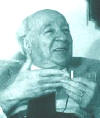|

|
abstract:
In the past it was
found that certain correlation functions in percolation models, at the
critical point, could be extrapolated exactly from finite size values. This
resulted in a number of exact correlations, mainly for bond percolation on
the square lattice, but on few occasions also for site percolation on the
triangular lattice. These results have been obtained by the study of the
Perron-Frobenius eigenvector of the transfer matrix for the cylinder or
strip.
In this presentation this approach is generalized, both for site percolation
on an arbitrary tiling of the cylinder with arbitrary rhombuses, and for
bond percolation on a sublattice of such (bipartite) tiling. The weights on
each rhombus are chosen such that they satisfy the Yang-Baxter equation. As
a result, the eigenvectors of the (generalized) transfer matrix satisfy
recursion relations that are known as q-Knizhnik-Zamolodchikov equations.
These equations can be solved for small-diameter cylinders, from which
correlation functions can be calculated straightforwardly. The results
contain so much structure, and are so regular that an extrapolation to
arbitrary sizes can be guessed.
|
|

|
abstract:
We consider the
classical occupancy scheme in which n balls are thrown independently in
infinitely many boxes, with positive probability p_j of hitting box
j=1,2,... The problem is to describe the asymptotic behaviour, as n tends to
infinity, of the number of occupied boxes K_n, and of the number X_{n,r} of
boxes occupied by exactly r balls, r=1,2,...
In the first part of the talk we shall review known results about K_n and
discuss the multivariate normal approximation to X_{n,r}. In particular, we
show that the joint convergence only holds when the probabilities (p_j)
satisfy a condition of regular variation. Examples of oscillatory behaviour
will be also given.
In the second part of the talk we shall discuss the occupancy problem with
random probabilities (p_j), generated by a multiplicative renewal process.
This is applied to the asymptotics of exchangeable coalescents with multiple
collisions.
Based on joint work with Andrew Barbour and Alex Iksanov.
|